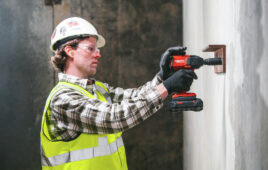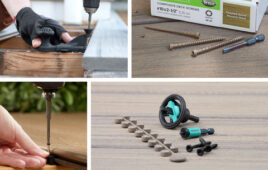by Venkat Nandivada, Manager, Technical Sales, Master Bond
Offering a nearly limitless assortment of end properties, epoxy systems enable higher density semiconductor electronics and economical, as well as enhanced reliability, while improving manufacturing efficiencies.
Today’s high performance electronic circuits that are designed into compact assemblies must meet a host of engineering requirements to ensure the reliability of the system. Advanced packaging technologies, such as flip chip assemblies, bare chip mounting, and ultra-fine pitch technology present challenges in terms of securing components to printed circuit boards (PCBs), preventing short circuits, dissipating heat, and protecting delicate components during the manufacturing process. To address these challenges, manufacturers often select environmentally friendly epoxy compounds that achieve high bond strength while providing other application specific benefits.

Epoxy compounds are often used for structural bonding in PCB assembly. Die attach adhesives bond components directly onto printed circuitry, protecting components from thermal cycling, mechanical shock and vibration.
Epoxy compounds perform multiple functions
Epoxies are versatile, solvent free polymer compounds that adhere well to many different substrates and produce strong, durable bonds. Formulated through a combination of one or more epoxy resins, a curing agent, and organic or inorganic fillers, epoxies can be modified in a variety of ways to achieve a vast assortment of performance characteristics. Among the properties that can be controlled through each specific formulation are cohesive strength, hardness, durability, flexibility, temperature resistance, viscosity, thermal conductivity, electrical conductivity, moisture resistance, chemical resistance, and resistance to shock and vibration.
Formulations can be engineered to withstand cryogenic conditions or ultra-high temperatures to bond specific materials or to meet stringent industry standards, such as NASA low outgassing specifications, UL 94V-0 flammability specifications, or USP Class VI biocompatibility tests. Many aerospace, defense and electronics companies develop their own specifications, approving specific grades of epoxy compounds made by select formulators.
The extensive array of epoxy formulations are available in a variety of formats and curing characteristics to meet different manufacturing needs–liquids, pastes, films, and solids. A wide selection of one and two-component epoxy compounds are available with cure schedules that range from snap cures, to elevated temperature fast cures, to prolonged cures at ambient temperatures — offering flexibility in terms of processing.
An epoxy system is typically categorized according to its primary function: adhesive, sealant, coating, or potting and encapsulation. In these roles, its main purpose is either to bond two substrates or to protect a substrate from environmental contaminants.
Because of their range of physical properties, epoxies are often engineered specifically to perform additional functions, such as dissipating heat, providing an electrically conductive pathway between substrates, or relieving stress between substrates. The performance and versatility of epoxy compounds can be a tremendous asset to the electronics industry. In this industry, epoxies make it possible to mass produce high density, high performance electronic assemblies, extending the life of electronic circuits, and enhance electronics manufacturing productivity.
Structural bonding
Because they offer exceptional adhesion to both similar and dissimilar substrates, epoxy compounds are often used for structural bonding in PCB assembly. Die attach adhesives, which are used to bond components directly onto printed circuitry, have good thermal cycling resistance as well as mechanical shock and vibration resistance — protecting fragile die from stress related failures.
Easy to dispense surface mount adhesives are engineered to deliver a consistent dot profile, fill voids, and withstand thermal stresses commonly encountered during wave and reflow soldering processes. Epoxies are excellent insulators, preventing short circuits between adherends; they can also be formulated to be electrically conductive if electrical continuity is desired. Grades are available that provide outstanding adhesion, even under conditions of high humidity and temperature.
Conformal coatings
Applied as a thin, uniform layer to electronic assemblies during the final stages of manufacturing, epoxy based conformal coatings protect against moisture, chemicals, solvents, abrasion, and mechanical shock and vibration. Designed to conform to the contours of an electronic assembly, these specialized coatings enhance the reliability of electronic assemblies by providing a barrier against the environment while strengthening delicate components and traces.
Numerous grades of epoxy based conformal coatings are available, each offers a different set of property tradeoffs to suit specific application requirements. Grades can be formulated to be thermally conductive or insulative, to resist thermal cycling and thermal shock, to absorb thermal stress, or to have outstanding dielectric properties. They can be engineered to withstand autoclaving sterilization procedures, which is required for many medical electronics applications, or to meet industry standards such as NASA low outgassing specifications and USP Class VI biocompatibility tests. Although they are often opaque, epoxy based coatings can be made clear for opto electronic applications.
Glob top encapsulants
Closely related to conformal coatings, epoxy based “glob top” encapsulants protect and support bare die and their wire bonds in chip-on-board (COB) assemblies. Bare die mounting to a PCB or substrate is common in space restricted electronic assemblies, such as handheld consumer and industrial devices. Glob top encapsulants protect vulnerable chips and wire bonds from contaminants while providing the mechanical support necessary to prevent stress related failures during handling and assembly. Although they exhibit many of the same post cure properties as conformal coatings, glob tops provide a thicker, more resilient barrier than do coatings, making them the preferred choice for delicate bare chip devices.

Epoxy based “glob top” encapsulants protect and support bare die and wire bonds in chip-on-board (COB) assemblies while providing the mechanical support necessary to prevent stress related failures during handling and assembly. Glob tops provide a thicker, more resilient barrier than do coatings, making them the preferred choice for delicate bare chip devices.
Specifically formulated to be thixotropic, glob tops flow smoothly in response to stress applied during application, but rapidly increase in viscosity. This allows them to easily cover the chip and fill narrow gaps between wires without damaging delicate parts, while preventing them from flowing beyond the desired area. The physical properties of epoxy based glob tops are carefully controlled to suit the COB application. Glob tops are electrically insulative, resistant to moisture and chemicals, and devoid of ionic impurities that may react with moisture to cause corrosion. They are free of solvents that may lead to bubble formation, which can result in penetration by moisture or contaminants. To minimize thermal stress, glob tops contain silica or alumina filler material, which reduces the CTE of the epoxy compound so that it is closer to that of silicon and gold.
Underfill encapsulants
Epoxy based underfill encapsulants are used to fill in the gaps between “flipped” silicon chips and organic substrates, such as FR 4, relieving thermal stress in the solder bump interconnects on these flip chip assemblies. These specially formulated epoxies mechanically couple the silicon chip and the substrate, forcing them to move in lockstep, while distributing thermal stress across the entire coupled area. As a result, there is very little differential movement between the chip and the substrate during thermal excursions.
Underfill encapsulants also protect the interconnects and the active surface of the chip from moisture and other contaminants, and provide mechanical support for flip chip assemblies. Since they are dimensionally stable, underfills withstand shock while maintaining alignment of the chip and substrate to minimize stress on the solder joints. Without underfill encapsulants, thermal stress caused by the thermal mismatch between the chip and the substrate would be concentrated in the solder joints — resulting in solder fatigue and premature circuit failures. Epoxy based underfill encapsulants have played a key role in the proliferation of reliable high density, high performance semiconductor technology.
Potting and encapsulation
Transformers, inductors, power supplies, connectors, sensors, relays, and other electronic components are often encased in epoxy based potting and encapsulation compounds to protect them against shock and vibration while providing a barrier to moisture and other contaminants. These compounds feature very low viscosity, allowing them to flow easily during application so that they completely cover the target surface; and a variety of other physical characteristics, including electrical insulation, thermal shock resistance, and low coefficients of thermal expansion (CTE). Different grades are optimized for specific applications, offering high voltage insulation or cryogenic serviceability, or meeting specifications such as NASA low outgassing, USP Class VI biocompatibility, and UL 94V 0 flammability.
Films and preforms
Solid epoxy adhesives, sold as small sheets of film or custom cut preforms, offer uniform bond lines with minimal squeeze out — benefits that are critical to certain applications in the electronic industry. When bonding heat sinks and other large surfaces, solid films are preferred because it is difficult to achieve a uniform bond line over a large surface area using liquid adhesives. For applications in which squeeze out may pose a problem, such as lid sealing or bonding substrates located near a channel through which ink or another liquid must flow, films and preforms are a better choice than liquid adhesives.

Epoxy films and preforms are ideally suited for applications requiring uniform bond lines and minimal squeeze out.
Epoxy films are manufactured as premixed, frozen adhesive films or as partially cured B staged adhesive films. While they differ in terms of storage, working life, and cure schedules, both types of films can be engineered to offer a variety of physical properties to meet specific application needs. Additionally, B staged adhesives can be applied in one stage of the manufacturing process and cured to completion in a later stage — even at a different location — presenting opportunities for process efficiencies.
Versatile epoxies improve reliability of electronic systems
Epoxy based adhesives, encapsulants, and sealants play a significant role in the manufacturing and assembly of modern electronic systems ranging from tiny, implantable medical electronics to massive space and defense systems. Versatile epoxy based compounds can be engineered for performance in a variety of harsh environments, including vacuum, cryogenic, and ultra-high temperature conditions, under conditions of thermal and mechanical stress, and in the presence of moisture, chemicals, and other contaminants. Because of their ability to prevent short circuits, extend joint life, and prevent stress related failures, epoxies are widely recognized for their contributions to the outstanding reliability and longevity of modern electronic systems. Offering a nearly limitless assortment of end properties, epoxy systems enable higher density semiconductor electronics and economical, reliable, high performance electronic devices, while improving manufacturing efficiencies.
Master Bond
www.masterbond.com





This a detailed and comprehensive overview of epoxy compounds. An informative read.
Ed of FinePitchAssembly.com